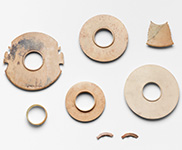Zhang Naiji
Individual
1899-1948
張乃驥
Chinese
Constituent Alternate Name(s)
N. C. Chang
Relations
Spouse: Zhang Mei Chien
Place of activity: Shanghai, China; New York, New York, United States;
Born to a prestigious family that made its wealth in the silk and salt industries, ZHANG Naiji (also known as Nai Chi Chang and N. C. Chang) grew up in Zhejiang province, China, just outside Shanghai. In 1917 Zhang married Xu Maoqian (known also as Mei Chien and Meiqian), and together they welcomed three sons, two of whom survived into adulthood: Nelson Chang (born 1923; his Chinese birthname is Zhang Zezhang ; he was also called Nanchen ) and Shelly Chang (born 1926; his Chinese birthname is Zhang Zelian ; he was also called Beiyu ).
Zhang began collecting coins early in life, and over the years he built an enormous collection that grew to include nearly thirty thousand pieces. His collection--impressive both in its size and its unique content--became well known in Asian numismatic circles. Along with other collectors, Zhang organized the numismatic society Guquan in 1926 and the following year contributed to the development of the Guquan zazhi (Journal of Ancient Coins), the first Chinese-language numismatic publication. When his father died in 1928, Zhang inherited a vast sum of money, which allowed him to diversify his collecting interests by purchasing scroll paintings, ancient bronzes, and archaic jades. Zhang's uncle, Zhang Zengcheng (zi sobriquet Jingjiang ; self-given nickname Renjie ), is best known for his support of the Chinese politician Sun Yat-sen (Sun Zhongshan ), yet he was also an avid art collector who owned Tonying & Company, an antiquity and curiosity shop in Paris. (C.T. Loo's first job in the art world was at Tonying.) Zhang later acquired fine examples of ancient jades from Loo and in 1935 loaned over forty pieces to the International Exhibition of Chinese Art at the Royal Academy, London.
During the Sino-Japanese War, Zhang relocated his family but left his coin collection behind. They sailed for New York City from Le Havre, France, in May 1939. C.T. Loo & Company, which later operated as Frank Caro Chinese Art, subsequently sold several of Zhang's pieces to private American collectors and institutions. In New York, Zhang avidly collected Chinese coins and fine arts, joining the American Numismatic Society in 1944 and the Chinese Art Society of America in 1948. In fact, the American Numismatic Society offered Zhang a position as curator of Chinese coins; it is unclear if he accepted the offer. He did, however, write essays and published the booklet An Inscribed Chinese Ingot of the XII Century AD (1944). Heavily invested in the stock market, Zhang encountered great financial problems in 1942 and began selling his antiquities collections for added income. He worked for C.T. Loo & Company and later with Oriental Fine Arts. Zhang returned to China in 1946 to bring back "the finest coins in his collection" and, quite possibly, his painting collection. C.T. Loo & Company later presented An Exhibition of Authenticated Chinese Paintings in 1948 to sell Zhang's art collection.
Zhang Naiji died in New York City on May 28, 1948. His wife, Zhang Maoqian sold his jades to C.T. Loo & Company and to J.T. Tai & Company. On December 1 and 2, 1949, the Park-Bernet Galleries auctioned some of his Chinese bronzes, ceramics, paintings, and tapestries; Kende Galleries sold the remaining pieces in June 1950. According to Zhang's descendants, several works that he left in China eventually found their way into the Shanghai Museum.
LITERATURE
Nelson Chang and Laurence Chang with Song Luxia. The Zhangs from Nanxun: One Hundred and Fifty Year Chronical of a Chinese Family. Denver: C. F. Press, 2010.
Thomas Lawton. "Paul Singer: A Sage among Collectors." Orientations 31, no. 5 (May 2000), 35--42.
Early Chinese Bronzes, Pottery and Porcelain, Chinese Paintings and Ko'ssu, and Tapestry Pictures in the Private Collection of the Late Nai Chi-Chang, Shanghai and New York, Sold by the Order of William F. Snyder ancillary administrator of his estate, Together with the Property of Oriental Fine Arts, INC., New York Acquired from the Late Nai Chi-Chang, Park-Bernet Galleries, December 1--2 (New York, 1949).
Chinese Art of the Sung to the Ch'ing Dynasty, Chou Ceremonial Bronzes, T'ang Terra Cotta Mortuary Figures (Including a Remarkable 65-Piece Cortege) . . . The Property of Oriental Fine Arts, Inc., New York City together with Property from the Private Collection of the Late Nai Chi-Chang, Shanghai and New York, Kende Galleries, June 13--14 (New York, 1950).
Nai Chi Chang. "An Inscribed Chinese Ingot of the XII Century AD." Numismatic Notes and Monographs 103. American Numismatic Society (New York, 1944).
Archaic Chinese Jades: Special Exhibition. Philadelphia: University of Pennsylvania, University Museum, February 1940.
Orvar Karlbeck. "Some Archaic Chinese Jade Pendants and their Dating." The Burlington Magazine for Connoisseurs 73, no. 425 (August 1938), 69--74.
Catalogue of the International Exhibition of Chinese Art, Royal Academy of Arts (London, 1935--36).
ARCHIVAL HOLDINGS
Loo Family Photographs. Freer Gallery of Art and Arthur M. Sackler Gallery Archives. Smithsonian Institution, Washington, DC (FSA2010.07)
June 3, 20

